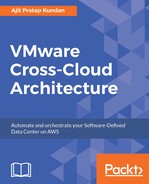VMware Cloud Foundation is a hardware integrated solution. This means that it not only provides software configuration, but also provides automation for much of the physical hardware configuration. The following diagram depicts the standard physical rack configuration for Cloud Foundation:

Figure 6: Cloud Foundation rack
A Cloud Foundation rack consists of the following components:
- Spine switches: This system comes with two spine switches that extend the network schema of the top of rack switches between racks and enables inter-rack connectivity. You can communicate between the uplink ports of the ToR switches and the spine switches. We require spine switches in multi-rack deployments, which are located in the second rack.
- Management switch: The management switch helps public connectivity with the baseboard management controller on each server. vSphere management, vSAN, or vMotion traffic runs on the network fabric generated by the ToR and spine switches. The management switch lacks redundancy in the physical rack. Components associated with management switches can't be customized or modified, but virtual machines/applications can be protected with maximum availability and performance.
- Top of rack switches: A physical rack comes bundled with two ToR switches, with 48 10GE ports and a minimum of four 40 GE uplink ports. The ToR and spine switches are capable of taking care of all network traffic (including VM network, VM management, vSAN, and vMotion traffic) from the servers with a guarantee of zero data loss and zero down time. The ToRs switches are designated for traffic to the main network through two of the uplink ports on rack 1. ToR switches are capable of providing more bandwidth with maximum availability for relentless operation. Each spine switch communicates with two Uplink ports from each ToR switch on every rack.
- Servers: You can scale up servers/nodes on the rack up to a maximum of 32 servers. It supports both scale up and scale out architecture. All servers/nodes should be of the same model and type within a rack. The disk size and storage configuration must be the same. Memory and CPU (per CPU core count) between servers can be different. Check the VMware Hardware Compatibility Guide for supported configuration.
